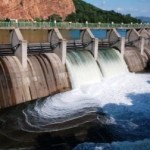The report describes three scenarios whereby developed and developing countries consume resources equitably: ‘Convergence by 2050’.
Scenario 1: Business-as-Usual in Developed Countries, Convergence by Others
Per capita resource consumption in the industrialized countries remains stable, as it has for the past three decades, and the rest of the world continues the current trend to catch up. This path leads to annual total consumption of 140 billion tons of minerals, ores, fossil fuels and biomass, or 16 tons per capita for a population of 9 billion, by 2050. Says the report: this “represents an unsustainable future in terms of both resource use and emissions, probably exceeding all possible measures of available resources and assessments of limits to the capacity to absorb impacts.”
Scenario 2: Moderate Contraction of Consumption in Developed Countries, Convergence by Others
Industrialized nations halve average per capita consumption to 8 tons and other countries rise to that level. The result: total world consumption of 70 billion tons in 2050. “This scenario pre-supposes substantial structural change amounting to a new pattern of industrial production and consumption that would be quite different from the traditional resource-intensive Western industrial model,” the report says.
This scenario results in global consumption of 70 billion tons by 2050 – about 40% more annual resource extraction than in 2000. Average emissions of carbon dioxide per capita would rise almost 50% to 1.6 tons per capita and global CO2 emissions would more than double.
Absolute cuts in consumption – well short of the scale required in scenario two – have occurred in just a handful of countries, and in some cases only because they have lowered their per capita consumption rate by importing resources from elsewhere.
Scenario 3: Tough Contraction of Consumption in Developed Countries, Converging with Others
Industrialized nations reduce per capita consumption by two thirds and other nations remain at current rates, resulting in a global per capita consumption rate of 6 tons and total world consumption of about 50 billion tons, the same as in year 2000.
This scenario would be so restrictive and so unappealing to politicians, that it “can hardly be addressed as a possible strategic goal,” the authors admit.
Yet, even such tough measures would maintain global consumption at levels many scientists still consider unsustainable. Average CO2 per capita emissions would be reduced by roughly 40% to 0.75 tons/capita and global emissions would remain constant at their 2000 level.
“These scenarios challenge our current thinking and assumptions about development,” says the report. “If investments in developing and developed countries are made today that lock humanity into a business-as-usual or moderately improved resource intensive growth path, the risks of running into ecological and supply constraints will worsen.”
“This finding has spurred the International Resource Panel to focus future reports on how to improve resource productivity and find viable alternatives for policy makers.”
Challenges Ahead
These include:
- Policymakers and the general public aren’t yet convinced of the absolute physical limits to the quantity of resources available for human use.
- The wide discrepancies in per person consumption mean different levels of action are required. Poorer nations, likely the first to feel the impacts of resource shortages, must have a chance to improve conditions in the developed world. But if they emulate a profligate style of growth, they not only expose their economies to supply constraints, the planet’s resource bank will go far deeper into the red.
- The best and most easily accessible mineral ores and fossil fuels are being exhausted. New sources are generally more remote and of lower quality. Finding and extracting them takes more energy and increases the environmental impact. About three times more material needs to be moved for the same ore extraction as a century ago, with corresponding increases in land disruption, water impacts and energy use.
- Resource extraction increasingly occurs in countries with lower legal and environmental standards, meaning “environmental impacts per unit of extracted material might become more severe.”
- As trade expands, it becomes more difficult to assign responsibility for resource consumption, a crucial consideration if each country is required to limit per capita consumption. Should the reduction of mining and its impacts, for example, be the responsibility of the country where the extraction takes place, the one where the ore is processed into a manufactured product, or the one where that product is consumed?
- A “rebound” effect often leads to increased consumption after energy or manufactured goods become more efficient as consumers take advantage of cost savings to buy something else, or use a device more often – for example: putting more kilometres on a fuel-efficient car.
Reasons for Optimism
- According to the report, the certainty that resource shortages will eventually preclude business as usual ensures that any country “ahead of the game” by investing in innovation “will clearly reap the benefits when pressures mount for others to change rapidly.”
- Developing countries, unburdened by existing technologies, can leapfrog to less resource-intensive processes and goods, as much of Africa has, for example, by bypassing hard-wired telephone services and moving directly to wireless.
- The rising cost of many resources creates an economic imperative to use less – although, at the same time, higher prices could allow exploitation of more expensive, environmentally hazardous sources such as oil from the high Arctic.
- Urbanization can reduce a population’s consumption rate since it makes the provision of services more efficient and “concentrate(s) the knowledge, financial, social and institutional resources required for sustainability oriented innovations.” However, the consumption numbers for cities can be artificially low if the urban area depends on energy and resources from the surrounding countryside. In addition, urban dwellers consume more as the economy grows. “This captures the dilemma of cities for sustainability,” the report states. “They drive the global unsustainable use of resources, but they are also where the greatest potential exists for sustainability-oriented innovations.”
- Even today, there is a vast difference in resource use rate across countries, even those with the same GDP per capita. This indicates that it is possible for countries to be much more resource productive, and still grow their economies.
Quotes
“We must realize that prosperity and well-being do not depend on consuming ever-greater quantities of resources. Decoupling is not about stopping growth. It’s about doing more with less. Global resource consumption is exploding. It’s not a trend that is in any way sustainable,” said Ernst U. von Weizsäcker, co-chair, UNEP Resource Panel, and Former Chair, Bundestag Environment Committee.
“Decoupling impacts and consumption from growth is an extremely important breakthrough – a way of unlocking the logjam brought about by the notion there must be a trade-off between economic development and the environment. Developing countries could change their idea of what development means in a resource-scarce world,” said Ashok Khosla, co-chair, UNEP Resource Panel; President, IUCN, and Founder, Development Alternatives, India.
“Consumption of resources has exploded since the time of our great-grandparents due in part to efficiencies leading to reductions in resource prices. With food, rare metals, energy and other resources rising significantly in real price terms now, pre-conditions for determined decoupling efforts are stronger than ever before.”
Check the following link to read/download the Full Report:
http://www.unep.org/resourcepanel/decoupling/
About the International Resource Panel
The International Resource Panel for short, was officially launched in November 2007 and is expected to provide the scientific impetus for decoupling economic growth and resource use from environmental degradation. The objectives of the Resource Panel are to:
- Provide independent, coherent and authoritative scientific assessments of policy relevance on the sustainable use of natural resources and in particular their environmental impacts over the full life cycle
- Contribute to a better understanding of how to decouple economic growth from environmental degradation.
Source: UNEP.














